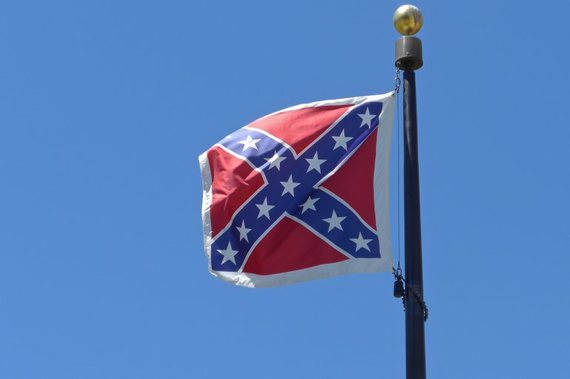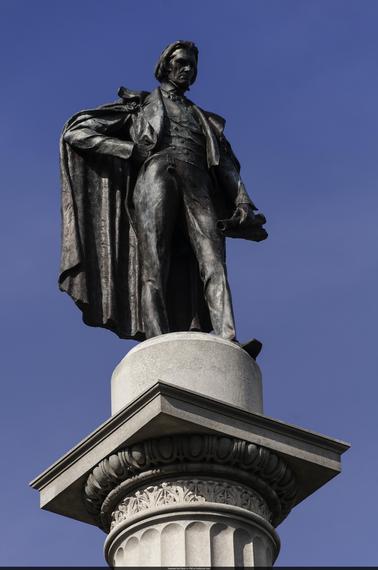Hauling down the Confederate battle flag from its staff on the grounds of the South Carolina Capitol in July marked a tectonic shift in white rulers' manipulation of the tragic racial history of the American South. It may have been just the beginning.
Triggered by a single act of hate and madness, the cold-blooded killing of nine African-American parishioners at bible study, the focus on the flag as a symbol of racist strife changed South Carolina politics in a moment.  Flying defiantly at the top of its solitary staff as the American and South Carolina flags were lowered to half-staff in mourning, the battle flag of an army defeated 150 years ago drew the angry eyes of millions watching television or tapping into the Internet.
Flying defiantly at the top of its solitary staff as the American and South Carolina flags were lowered to half-staff in mourning, the battle flag of an army defeated 150 years ago drew the angry eyes of millions watching television or tapping into the Internet.
Republican Governor Nikki Haley quickly sensed the shift in political sensitivity and led her party and state to strike the colors and move them to the state's museum of Confederate relics and military history. It was, after all, the battle flag of a defeated army forced to drop it at Appomattox on April 10, 1865, the day after General Robert E. Lee surrendered to General U.S. Grant, ending the bloodiest chapter in American history.
"Then, slowly and with a reluctance that was appealingly pathetic, the torn and tattered battleflags were either leaned against the stacks (of Confederate muskets) or laid upon the ground," wrote Joshua Lawrence Chamberlain, the Union commander appointed to supervise the disarming of the defeated rebel troops. "The emotion of the conquered soldiery was really sad to witness. Some of the men who had carried and followed those ragged standards through the four long years of strife, rushed, regardless of all discipline, from the ranks, bent about their old flags, and pressed them to their lips with burning tears."
Nonetheless, the beaten and bedraggled soldiers gave up their arms and flags under the watchful eyes of the victors and, when they had done so, were released to return to their homes in peace. In the weeks that followed, other Confederate armies surrendered and likewise turned in their standards. It was only in bitter defiance years later that white Southerners took up the banner again as a symbol of their opposition to the civil rights laws imposed on them by the Congress and federal courts.
The flag had hardly been furled and carried off to its resting place than a drumbeat began for a reexamination of other public symbols of that tarnished age.
"Not the statues," insisted many a white Southerner raised under the watchful eye of cast bronze Confederate generals on horseback, Civil War-era political leaders and ordinary soldiers standing guard--often facing north. Those statues erected throughout the South in the decades after the Civil War were not the only memorials, of course. Buildings, highways, ferries and public places were named in honor of those who fought what many considered a good fight. Some, undoubtedly, will remain standing, but others already are targets of civil rights activists fed up with the romanticizing of a war fought to preserve slavery. And it wasn't just the war. Some of those white leaders were memorialized for reinstituting racism years after the war in Jim Crow laws and terrorist bands like the Ku Klux Klan.
The defense, mostly by whites, contends that the statues and memorials commemorate legitimate figures in Southern history and should not be disturbed in an attempt to cleanse or bury leaders of the lost cause. But to the extent that they were erected to honor their subjects, it is equally legitimate to question the actions of those being so honored.
Even before the massacre in Charleston, the University of North Carolina at Chapel Hill struggled with a name carved into a prominent academic building on campus to honor William Lawrence Saunders, a lawyer, elected North Carolina secretary of state, a university trustee, collector of colonial documents--and bearer of the title Emperor of the Invisible Empire, Knights of the Ku Klux Klan. In the first years after the war, Saunders led the KKK in North Carolina, although the organization was banned by Congress as a white-supremacist terrorist organization. In May, after years of protests and demands by university student and faculty activists, the board of trustees decided that members of the board nearly a century before had made an error by citing Saunders's role in the KKK as a reason for naming the building in his honor. To correct the error, the board voted to rename the old history building Carolina Hall. But in an attempt to head off any suggestion that its reexamination of the case was the beginning of a trend, the board announced a 16-year moratorium on changing the names of any other buildings on campus.
Elsewhere in the South, activists are at work seeking to change the names of other hallowed places, including buildings at Duke University, the University of Texas at Austin, and Clemson University in South Carolina. In response to defenders of the status quo, activists have argued that African-Americans weren't among those who picked the honorees in the days when white racism ruled the South.
Daron-Lee Calhoun II of the Avery Research Center for African American History and Culture explained why he would be happy to see the removal of a statue of one of the white South's most venerable 19th-century leaders. John C. Calhoun, who served as vice president of the United States under two presidents, was among the principal defenders of the institution of slavery, owned slaves himself and argued in both the House and Senate for recognition of a state's right to reject federal laws with which it didn't agree. As a descendant of Calhoun slaves who were given the surname of their owner upon emancipation, Daron-Lee Calhoun sees an altogether different figure when he looks up at the imposing sculpture of the famed orator looking down from a pedestal high above Marion Square Park in Charleston.
"Every day I drive down Calhoun Street and see that statue," he told Christof Putzel of Al Jazeera America. "There has not been one statue I despise more in my life. Everything that he believed in, everything that he stood for goes back to slavery."
____________________________
Disclosure Note: Christof Putzel is the son of Michael Putzel, author of The Price They Paid: Enduring Wounds of War, and the writer of this blog.

